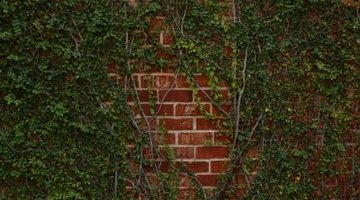How to Get Rid of Ivy From a Chimney
Ivy growing up the side of a brick structure, including chimneys, softens the edges, can complement the design of your landscape and presents curb appeal. If the structure is old and the masonry has weakened with age, however, the ivy roots can grow into small cracks, widen the cracks and give water an opportunity to penetrate. Removing the ivy every few years helps to avoid this situation and keeps the growth under control. This is not a quick process, but you can complete it with a little time and hard work.

-
Put on gloves to protect your hands and cut the trunk of the ivy plant with pruning shears or loppers. Make the cut 4 inches from the base and allow the ivy to die and dry out for a few days.
-
Work the ivy off the chimney using a scraping and gentle pulling technique. Hold a wood scraper almost flat against the brick, scrape loose the ivy stems and gently pull them off. If the chimney goes from ground level to above the house, start at the base of the chimney. For higher, out-of-reach places, use a ladder. Be sure the ladder is on solid, level ground, and have an assistant hold and steady the ladder while you are on it. You may need to cut larger stems with pruning shears first.
-
Scrub the chimney with a dry nylon brush to remove the hairy tendrils. For hard-to-remove tendrils, use a stiffer bristled brush and a soapy mixture of water and a mild detergent. The stiff brush can scratch the bricks so test this process on a less visible area.
-
Burn off stubborn ivy tendrils and residue with a propane torch as a last resort. Keep the flame moving back and forth and do not concentrate on one area for too long. This could damage the mortar or scorch the surface of the bricks. Test this technique on an inconspicuous spot.
References
Resources
Warnings
- Do not use a wire brush because it can easily scratch the brick's surface or damage the mortar.
- If you use a torch, keep the flame away from all wood and flammable materials.
- Avoid using herbicides because they tend to leave a white residue and can negatively affect the bricks and mortar.
Photo Credits
- Photos.com/Photos.com/Getty Images
More Articles



